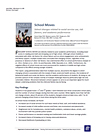This report, using administrative data from multiple sources, describes the degree to which changing schools is associated with the receipt of basic social and health services, the incidence of behavioral health and social risk factors, and the academic performance of students. Students in two grade levels—1st and 7th grades—were followed over three consecutive school years, and the number of school changes during that time were counted. While slightly more than half did not change schools, about 45 percent of the students changed schools at least once, with 7 to 10 percent changing school three or more times during the three years. Increases in the number of school moves were associated with more use of social services for such basic needs as food, cash, and medical assistance as well as more use of child welfare services and foster care. Changing schools was also associated with greater risk for homelessness, mental health problems, substance abuse, arrests, and involvement with the juvenile justice system. School performance appeared to be adversely affected by school moves. As the number of moves increased, we found poorer performance on standard reading and mathematics tests, lower average grades, increased chance of dropping out or having unexcused absences, and decreased likelihood of graduating on time. The report provides a picture of the complex overlay of multiple challenges faced by particularly high-risk and vulnerable children. Movement between schools appears to serve as an important signal for much deeper underlying problems that the child and family may be facing.
Report and/or Additional Information:
Related Publications:
- Behavioral Health Needs and School Success (11.194)
- Connections to Employment and Education (5.38)
- Education and Well-Being of Children in Assisted Housing Programs (11.238)
- Education Measures for Children on TANF (11.210)
- Educational Disabilities Among At-Risk Students (11.190)
- High School Outcomes for DSHS-Served Youth (11.181)
- Homeless and Unstably Housed K-12 Students in Washington State (11.214)
- Postsecondary enrollment patterns among recent graduates who received social and health services during high school (11.196)

